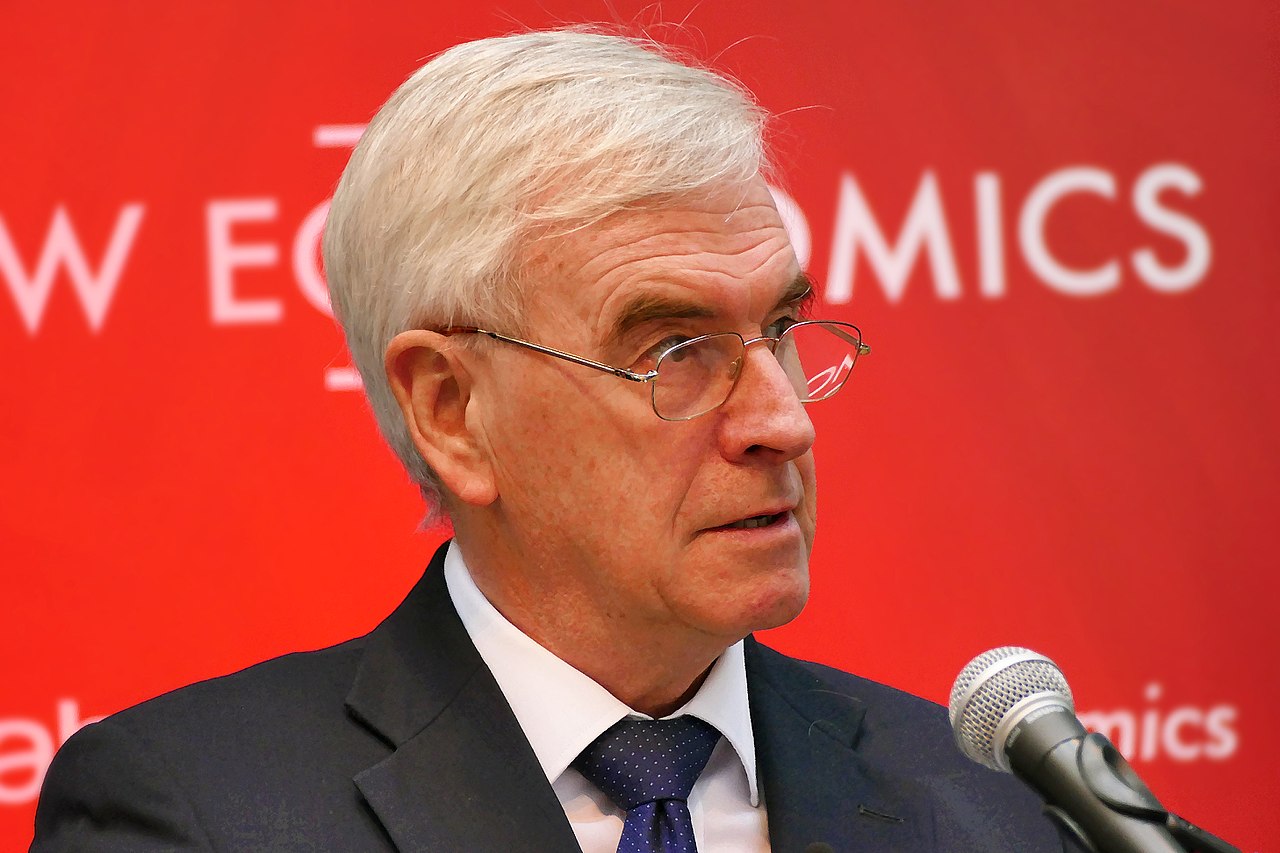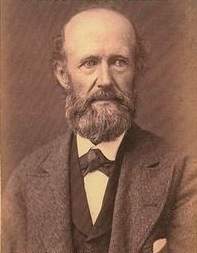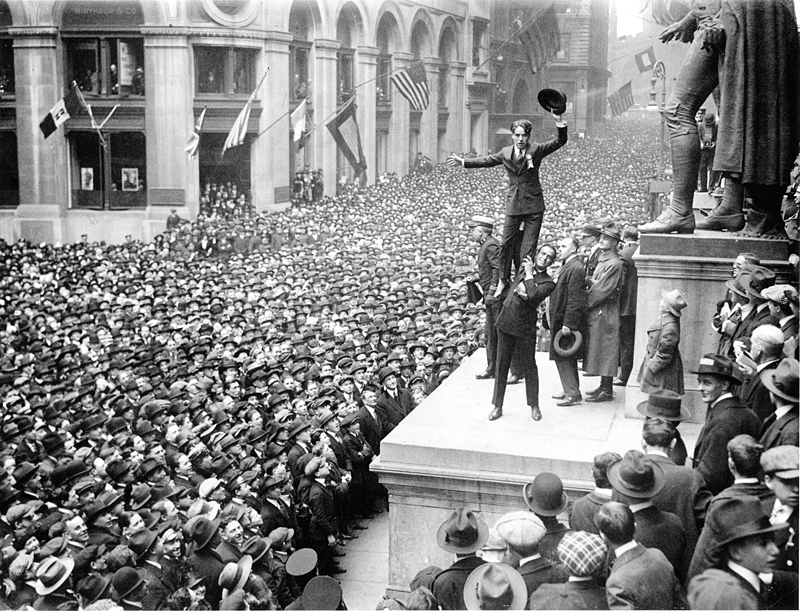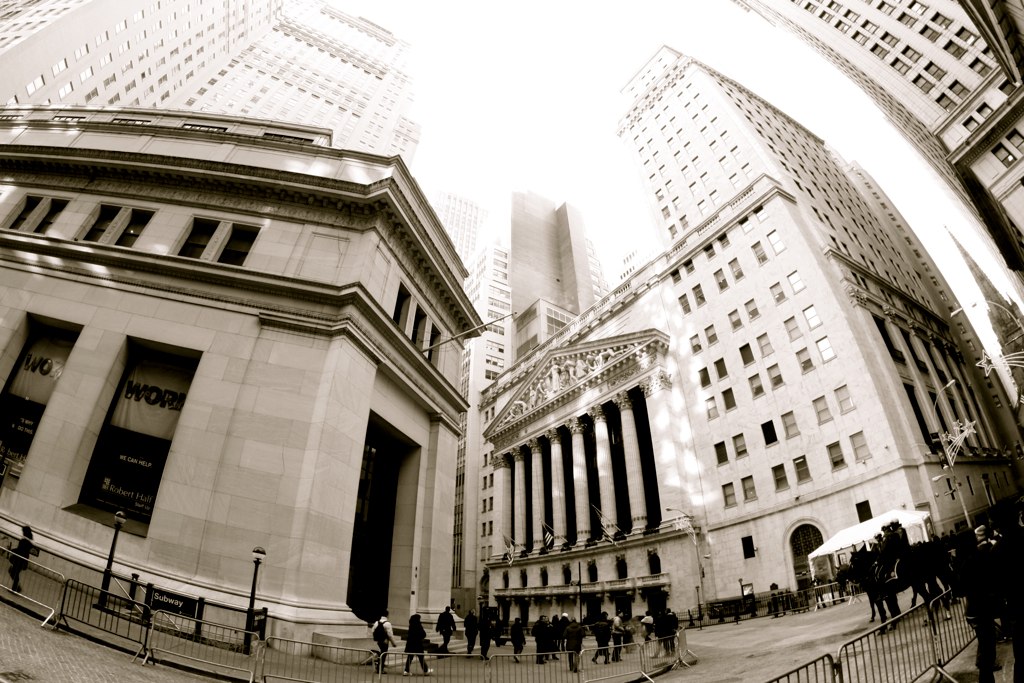The Next Shareholder Revolution
Owen Davis
STATE OF POWER 2019
January 15, 2019
A surprising concern has arisen recently on Wall Street: markets are becoming socialist. The culprit is passive investing, the use of quasi-automated vehicles that provide access to broad stock indexes with minimal cost and effort. The rush into such products – and the decline in human stock-picking – recalls, to some, a form of socialism.
As one analyst wrote, ‘If everybody does the same thing, the index becomes the market resulting in the equivalent of investor socialism’. Another called passive investing ‘worse than Marxism’. For famed hedge fund manager Paul Singer, such funds are ‘devouring capitalism’.
The idea that finance could be a socialising force is an old one on the left. For radicals going back to Marx and his forebears, corporate stock provided a template for both the socialisation of ownership and redistribution of income.
The argument has precedent. In 1914, a prominent German banker surveyed the growing consolidation of industry under the control of major banks and grew uneasy. ‘One fine morning we shall wake up in surprise to see nothing but trusts before our eyes, and to find ourselves faced with the necessity of substituting state monopolies for private monopolies’, he wrote. Financiers would have abetted the rise of socialism, he argued, ‘accelerated by the manipulation of stocks’.
Evident then, as now, was a seeming paradox: that the tools of finance might serve ends other than pure capitalism. Indeed, the idea that finance could be a socialising force is an old one on the left. For radicals going back to Marx and his forebears, corporate stock provided a template for both the socialisation of ownership and redistribution of income.
Today, progressives, social-environmental activists, and even socialists are gathering around the stock market, that border space between the productive economy and the financial system. Through the ownership of corporate equity, they hope to spur changes in areas as diverse as climate justice, money in politics, gender and racial inclusion, and economic inequality.
In effect, they want a second shareholder revolution. The first, launched in the 1980s, saw the reorientation of business away from an array of stakeholders – managers, consumers, labour – to stock-owners alone.
Spearheading this revolution were the infamous corporate raiders, joined by investors thirsty for returns after a long profit drought. Together they realised the vision Milton Friedman outlined in 1970: that corporate managers should ‘conduct the business in accordance with [shareholders’] desires’, that is, ‘make as much money as possible’. Shareholder value became the sole end of business.
Agitating for the next shareholder revolution are three groups I refer to as social shareholders. These include ethical activists, who use stock to push corporations on environmental issues, executive pay and the like; pension funds, which have the ability and, increasingly, the inclination to use their trillions of dollars in assets to nudge businesses towards social responsibility; and advocates of sovereign wealth funds (SWFs), publicly managed pots of money that pay back into the commonweal.
Alongside the social shareholders are politicians ranging from US Senator Elizabeth Warren to British Shadow Chancellor John McDonnell, who are pushing to place workers on corporate boards and to establish worker employee funds.

John McDonnell giving a speech in Preston on Labour’s ‘New Economics’ programme in February 2018. Credit: Sophie Brown/Wikimedia | CC-BY-SA-4.0
To understand how these forces came about and where they might go, I present a historical sketch that explores the tradition of left and progressive plans to strategically exploit the stock market, from the utopian socialists of the early 1800s to civil rights activists of the twentieth century and beyond. In this context, we can better evaluate the prospects faced by social shareholders in the financial capitalism of today.
Social shareholders have the potential to realise radical aims to the extent that they embody a new power structure power within global markets. Smaller, disassociated shareholders gain leverage when they meet with larger allies, as pension funds have done for activists. If SWFs and other public vehicles take on the new role of centralisers, around which others cohere and magnify their voices, the combined power might finally provide a counterweight to financial capital within the ambit of finance.
Definitions – From shares to social shareholding
Before casting back into history, though, some context is in order.
Shares of companies account for about $80 trillion of wealth worldwide, of which US market capitalisation makes up about 40 per cent (for this reason, and because the US leads the way in stock market developments, much of this account will be US-focused). Global stock market wealth represents 110 per cent of global Gross Domestic Product (GDP), up from 30 per cent in 1980. Listed companies make up a major share of employment and economic activity in developed countries. The wealth of nations is, more than ever, the financial wealth of corporations.
What is a share? To a new company, it is lifeblood. Once sold, the share becomes a barometer of investors’ beliefs. Functionally, it is a promise of future income. Day to day, its price on public exchanges follows hopes, hunches and crowd psychology, rooted in a collective estimate of future profitability.
The second key fact of shareholding involves ownership. Convention holds that the owners of Apple stock collectively own Apple Inc., just as I own my iPhone. Legally, this is not quite true. Shareholders simply own bundles of rights: to collect dividends and to weigh in on high-level decisions, like who sits on the board or whether a corporate buyout should go through.
More prosaic matters – say, whether Apple should give the iPhone a normal headphone input again – lie outside shareholders’ reach.
Here it is worth noting two egalitarian potentials intrinsic in the corporate form: collective ownership (of a kind) and wealth redistribution. If the economy were a single corporation and every citizen a shareholder, two of the chief goals of socialism would be met.
Who are the shareholders? Rich people, mostly. In the US, the wealthiest 10 per cent of households own 84 per cent of corporate stock outstanding. But the ranks of stock owners also include pension funds securing workers’ retirement incomes, colleges plumping endowments, insurance companies stewarding assets, hedge funds playing the markets, individual households putting away savings, big banks and asset managers.
Mixed into these groupings are what I call social shareholders. Broadly, they can be defined as those whose stock ownership is driven by non-pecuniary motives, typically political or ethical, and/or exists to further a redistributive goal.
Most familiar are the ethical activists, as distinct from hedge funds and other purely profit-seeking activist investors. Ethical activists buy stocks in order to lodge criticisms, file resolutions, and cajole other shareholders into voting their way. Since the 1970s, they’ve been a fixture in annual meetings, pushing for everything from governance reforms to climate adaptation.
Recently they have included nuns pressuring US gun manufacturers to account for the toll of mass shootings and a coalition calling for drug companies to address the opioid epidemic. British activists have pushed at least 4,000 companies to adopt living wage policies.
Next come pension funds. For as long as pensions have existed, they have used the pooled retirement savings of workers more or less politically, from financing public housing to wielding their assets in labour–management negotiations. But in recent decades, particularly in the US, pensions have expanded their investment offices and focused their holdings on a broader set of issues in business, notably executive compensation.
Finally, there are the sovereign wealth funds. To date, most such funds owe their existence to oil revenues, such as those in the Arab Gulf States and in Alaska, though other funds have sprung up in places like New South Wales in Australia. Calls have multiplied among progressives for publicly owned funds that might distribute their dividends as a sort of universal basic income. Notably, Hillary Clinton considered adding the idea to her 2016 presidential platform, inspired by Alaska’s success.
Unlike pensions and ethical activists, the purpose of SWFs is primarily distributional, a fact especially apparent in the recent SWF proposals, of the American Matt Bruenig. and Stewart Lansley in the UK.
Both imagine SWFs as public vehicles that collect financial assets by taxes or levies and distribute dividends directly to citizens or finance public investments. SWF-like ideas have also arisen in recent political proposals. US Senator Cory Booker proposed a fund that would collect assets to be distributed to low-wealth young adults, a proposal that has the general shape of a SWF.
Other plans go beyond distributional concerns to focus on democratising control of production: British Shadow Chancellor John McDonnell’s Inclusive Ownership Fund would require large companies to transfer stock to worker funds; US Senator Elizabeth Warren would follow Germany’s lead and give workers seats on corporate boards.
The grouping of social shareholders outlined above reflects more a stylistic choice than any existing alignment. Yet as will be seen below, the groups are likely to encounter mutual advantages and interconnections. An open question is how SWFs, together with other government-directed corporate governance initiatives, might transform the broader landscape of shareholder power and reimagine – to use an unfashionable phrase – corporate democracy.
History of the Social Shareholder
Birth of the corporation
The corporation emerged as a tool of conquest. European governments needed a way to finance trade ventures without risking too much individual wealth. In 1602, the Dutch East India Company became the first company to sell shares to the public. The company’s monopoly over the spice trade in southeast Asia allowed it not only to trade but essentially make war. An early windfall came in the plunder of the Santa Catarina, a 1500-ton Portuguese carrack, near Singapore in 1603.
As soon as was there were shareholders, however, there was shareholder activism. Rival investors battled for control. Then there was the issue of the Santa Catarina. Though its booty had enriched the shareholders, pacifist Mennonite investors complained that they were essentially financing piracy. They faced a dilemma that would become a commonplace in ethical activism: whether to engage as owners, or to divest and wipe their hands. They did the latter.
Other colonial powers soon chartered their own enterprises, which came to be known as joint-stock companies. But it was not until the Industrial Revolution that these enterprises began to resemble modern corporations.
As production grew in size and complexity, particularly in Britain, the needs of capital outgrew the capacity of the partnership or sole proprietorship. By offering ownership shares to the public, the joint-stock structure allowed for larger operations and smaller risks for entrepreneurs.

John Bray (1809-1897)
Soon enough, these financial innovations inspired radicals. Among them was John Francis Bray, a US-born printer who influenced early Anglo-American radical movements. Bray saw in joint-stock enterprises ‘the best exemplification of the power which man may wield’, whose ‘gigantic power’ was found in ‘innumerable roads, railways and canals, and in the creation and distribution of almost every description of wealth’.
In Bray’s utopia, the economy would be ‘one great joint-stock company’, free of competition and subdivided into many subsidiaries. Communities would ‘universally produce or distribute wealth, and exchange their labour and their productions on one broad principle of equality’.
Bray left the details vague, but his ideas prefigured later arguments about the socialising potential of corporations. By dispersing ownership claims, joint-stock companies encouraged a more fluid distribution of profits. It is no great conceptual leap to imagine a socialised economy consisting of a few great joint-stock companies in the largest industries – shipping, communications, manufacture – their shares evenly distributed. Nor was Bray the only early socialist to build a utopia on the foundations of the joint-stock company.
In 1842, the pseudonymous Aristarchus proposed a system of ‘Interchanging Joint-Stock Companies’, which would form a ‘community of profits’ to supersede the ‘community of property’. A pamphleteer called John Frearson envisaged a society of ‘equitable joint-stock companies’ run by ‘working shareholders’.
Of course, workers could simply bypass the financial system and organise production themselves. Worker-owned cooperatives sprung up around Europe and the US in mid-1800s – to Marx they represented ‘within the old form the first sprouts of the new’ – and have been a fixture, if a marginal one, within capitalism ever since. In the US, black cooperatives joined economic solidarity with racial emancipation. Yet the growth of cooperatives has been constrained by competition and access to capital.
Few socialists better appreciated the revolutionary potential of corporations than Karl Marx. For him, the divorce of ownership from control represented ‘a mere phase of transition to a new form of production’. The single, private capitalist was being supplanted by collective, ‘social’ capital, which was ‘distinct from private capital’. The joint-stock company became ‘the abolition of the capitalist mode of production within the capitalist mode of production itself’.
Marx had some personal experience in this department. ‘I have, which will surprise you not a little, been speculating’, he wrote to a friend after coming into a windfall in 1864. Betting on a bubble in English joint-stock companies, which were ‘springing up like mushrooms’, Marx made a purported £400 – nearly £50,000 today. His justification: ‘It’s worthwhile running some risk in order to relieve the enemy of his money’.
The Gilded Age
Despite Marx’s hopes, corporations generally served a purely capitalist function. Perhaps no country took to corporations as energetically as the US. Following the Revolutionary War, the young states issued a flurry of corporate charters. These entities served a range of purposes both civic and commercial, from schools to banks to cotton manufactories. Nearly all of them promised some ‘public utility’ beyond that of profit-making.
But US corporations soon shook off their civic attire. By the mid-1800s most operated under the control of a small coterie of shareholders who appointed close associates as managers. Towards the end of the century, tycoons like John D. Rockefeller enacted a wave of mergers through complex stock manoeuvres and, occasionally, outright fraud. The corporation, once an expression of democratic impulse, became the locus of gilded-age plutocracy.
A similar process took place in Germany. Its highly concentrated banking system had consolidated industry to the point where equity finance seemed a relic. Bank loans to corporations supplanted stock issues, and Germany’s so-called Big Three banks owned so much stock that exchanges atrophied.
To Rudolf Hilferding, theorist and Weimar Republic finance minister, this evolution betokened a new stage in capitalism: that of ‘finance capital’. For Hilferding, it was not the corporation that held revolutionary potential, but the banks. ‘Taking possession of six large Berlin banks would’, he wrote, ‘greatly facilitate the initial phases of socialist policy’– just as German bankers feared.
Banks were also ascendant in the US, where the likes of Andrew Mellon and J.P. Morgan helped forge twentieth-century US capitalism. But unlike in Germany, Wall Street’s rise empowered the small shareholder, as companies made use of the New York Stock Exchange to mass-market their shares. Between the start of World War I in 1914 and the end of the 1920s, the portion of US households owning stock rose from around 3 per cent to nearly one quarter. Then came 1929.

Charlie Chaplin stands on Douglas Fairbanks’ shoulders during a Liberty bonds rally. Liberty bonds were war bonds sold to support the allied cause in World War I. The bonds introduced the idea of financial securities to many citizens for the first time. Credit: Underwood & Underwood (see lens.blogs.nytimes.com) [Public domain], via Wikimedia Commons
The Golden Age
The Great Depression altered the face of corporate governance for generations. With New Deal legislation came limits on how much corporate equity a bank could own. A new paradigm took hold for executives and shareholders: professionalisation of the former, marginalisation of the latter.
This was the age of managerialism. In their 1932 classic, The Modern Corporations, New Deal economists Adolf Berle and Gardiner Means described how buccaneering investors had given way to staid careerists in charting the course of corporations. With shareholders facing irrelevance, the ‘traditional logic of property’ no longer held.
Looking ahead, they suggested a ‘purely neutral technocracy’, should control the great corporations, resolving stakeholder disputes and distributing income ‘on the basis of public policy rather than private cupidity’. Inspired by this analysis, Marxist economists Paul Baran and Paul Sweezy declared that shareholder control was ‘for all practical purposes a dead letter’.
Although some of this was overstatement, it was true that major shareholders and financiers had had their wings clipped just before the golden age of capitalism took off. But the New Deal legislation that established bodies to police Wall Street also empowered small shareholders to exercise their voice in new ways. Thus, in the nadir of financial power, a new breed of shareholder was born: the corporate gadfly.
The gadflies reflected the social currents of their time. In 1949 Wilma Soss began gate-crashing the annual meetings of companies like US Steel and lobbying for the inclusion of women on their boards. (Around one-fifth of listed US companies still have no women directors.)
In 1948, Civil Rights activists James Peck and Bayard Rustin bought one share each of Greyhound Corporation and submitted a proposal for it to consider desegregating its southern bus lines. While companies could generally block such proposals, with regulatory approval, by 1970 regulators sided with the gadflies. The floodgates opened to ethical activists, particularly environmentalists and Vietnam war protestors, as long as their proposals avoided focusing on ‘ordinary business operations’.

Shareholder activism emerged with the civil rights movement. Credit: Leffler, Warren K., photographer [Public domain], via Wikimedia Commons
The golden age of capitalism also produced attempts to consolidate economic gains within social vehicles. Progressive economists like James Meade landed on the idea of public funds that would invest in financial assets and deliver payments – social dividends – to citizens. The British Labour party in 1973 floated a ‘Workers Capital Fund’, whose goal was ‘extending opportunities for economic democracy by giving Fund members – through their ownership of shares – direct powers over key financial decisions’. US economist John Roemer proposed a similar plan in the 1990s.
The most ambitious application of such a fund took place in Sweden. Authored by economist Rudolf Meidner, the plan proposed to transfer corporate stock into publicly owned ‘wage-earner funds’ until they were majority owners. What took effect, however, was a watered-down compromise; from 1984 to 1991 only 5 per cent of Sweden’s equity entered the funds. It was ultimately ‘a rather symbolic gesture’, according to Meidner.
This was, after all, the age of Thatcher and Reagan. After a period of relative quiescence, the forces of financial capitalism had been gearing up for a counter-revolution. In the 1980s, they pounced.
Maximising shareholder value
In 1976, business theorist Peter Drucker warned that the rise of pension funds – which then held around a quarter of outstanding US equities – would produce ‘pension fund socialism’. According to Drucker: ‘If “socialism” is defined as “ownership of the means of production by the workers” . . . then the United States is the first truly “Socialist” country’.
It is ironic, then, that the neoliberal power shift back towards finance was abetted by US pensions. In the 1960s and 1970s pensions (both public-sector and those operated by private-sector unions) emerged as powerful investors. With their newfound financial might, labour-backed pensions sometimes deployed their funds in the service of workers, particularly during union negotiations. Yet the primary purpose of the funds was pecuniary.
Previously, institutional shareholders – insurance companies, mutual funds, pensions, etc. – were marginal players. But their portion of US stock ownership rose from 6 per cent in 1960 to 28 per cent in 1980 (today that share is around 80 per cent). The growth of institutions coincided with a crisis of capitalist profits, amid oil shocks and ‘stagflation’. By the 1980s, institutions were agitating for management to shake up their ossified bureaucracies and get cash flowing again. Pensions, tasked with providing retirement security for millions, were no exception.
Pension funds made their influence known in the wave of hostile corporate takeovers in the 1980s. When companies felt targeted, they often adopted ‘poison pill’ measures to ward off corporate raiders. These were generally seen as harmful to shareholders, since they discouraged takeovers that could yield stock returns.
Labour-run pensions soon fell in with the rest of the shareholding class. As scholars Schwab and Thomas wrote, ‘Labor unions are active again – but this time as capitalists’.
Pension funds were initially divided over the tactic. Public pensions stood with other institutions against poison pills, arguing that they had a fiduciary duty to oppose measures that threatened beneficiaries’ returns. But union-backed private-sector funds faced a conflict: takeovers often entailed layoffs and even the capture of pension assets.
Nonetheless, labour-run pensions soon fell in with the rest of the shareholding class. As scholars Stewart Schwab and Randall Thomas wrote, ‘Labor unions are active again – but this time as capitalists’.
Though commonplace now, the idea that businesses should operate exclusively to reward investors required a new intellectual framework: shareholder value theory. Economist Michael Jensen argued that corporations could act sensibly only if they focused entirely on maximising shareholder returns. Milton Friedman pondered, ‘If businessmen do have a social responsibility other than making maximum profits for stockholders, how are they to know what it is?’
The beneficiaries of this movement were not just pensions. As investors reclaimed their place at the top of global capitalism and policymakers cleared away regulations, Wall Street and the City of London thrived. Hedge funds multiplied, empowered by the logic of shareholder maximisation. In the name of aligning management and shareholder interests, companies increasingly rewarded executives with stock, a trend that helped to balloon CEO pay.

Wall Street district. Credit: Lafra/Flickr | by-nc-nd/2.0
Fifteen years after Drucker warned about pension fund socialism, he came to a different conclusion: pension funds had grown too capitalistic. The inability of capitalists to reckon with the rise of pensions had led, Drucker wrote, to ‘much of the financial turbulence of the 1980s – the hostile takeovers, the leveraged buyouts, and the general restructuring frenzy’. He concluded: ‘As a theory of corporate performance, then, “maximizing shareholder value” has little staying power’.
Drucker would again be proven wrong. But as pension funds matured, their approach grew more nuanced. Throughout the 1990s and 2000s pensions launched the majority of governance-related proposals, seeking to increase accountability among corporate management.
A recent pension-led campaign pushed the number of Standard &Poor’s 500 companies allowing proxy access – a policy that allows investors more easily to challenge board incumbents – from 1 per cent in 2014 to nearly two-thirds today.
Potentially more consequential, however, have been the ripple effects created by the emergence of institutional investors as structuring agents within the stock ecosystem.
Their rise gave the previously hodgepodge ethical activists more powerful and concentrated targets for their campaigns. A single pension fund fiduciary is easier to convince than innumerable dispersed shareholders. The confluence of these factors holds lessons for social shareholders in the future.
Looking Ahead
Three broad themes emerge from the history of social shareholders. First, there has always been, as John Maynard Keynes put it, ‘the tendency of big enterprise to socialise itself’. For as long as the corporate form has undergirded industrial capitalism, social activists have reimagined that form in an egalitarian or democratising light. There is, arguably, a real socialising potential inherent in the form of equity finance.
The second lesson is the importance of legal frameworks in regulating shareholder power. Activist investors won new rights in the mid-twentieth century, yet remain fundamentally limited in their influence over corporate affairs. Pensions have similarly expanded their ambit, but remain hamstrung by law – and perhaps their own beneficiaries – to look after the bottom line before anything else.
For these groups to approach real control over corporate affairs would require a regime change. A shareholder coalition that wished to keep ExxonMobil’s oil in the ground or to split up Facebook currently faces intractable barriers, not only in the law, but in the logic of capitalism itself.
Finally, size matters. Few developments have been so decisive in the power of the social shareholder than the growth of institutional shareholders, which fundamentally changed the nature of corporate governance. As researchers have found, the more institutional ownership a stock has, the more likely it is to be targeted by activists (ethical or otherwise).
Yet even if we classify pension funds unambiguously among them, social shareholders still control just a fraction of the stock market. Their antagonists include hedge funds, whose activism focuses primarily on disgorging cash and ousting board members, and mutual funds, which pursue similar goals through quieter methods.
Then there are executives themselves, significant holders of corporate stock. The structure of a firm’s stockownership, particularly its institutional makeup, matters for how it is run. Researchers have found that funds with more institutional ownership (particularly ‘transient’ owners like short-termist hedge funds) invest less and offload more cash to shareholders.
Dominating the markets are gargantuan asset managers like Vanguard, Amundi and Aberdeen. It is here that stock markets have most evolved since the financial crisis. Asset managers’ passive trading vehicles have attracted trillions of dollars, disrupting their competitors and reorienting shareholder power.
Passive ownership means that large investors do not sell when they are upset with a company; instead, somewhat paradoxically, passive investors engage. They also constitute vectors for activism: Getting BlackRock or Vanguard on your side often means winning a shareholder battle. It helps that these companies have warmed to environmental and governance concerns.
Rudolf Hilferding wrote that capturing the six largest banks would pave the way for socialism. Today he might say that socialising the six largest asset managers would facilitate the transition towards an egalitarian economy. In the absence of a citizens’ takeover of BlackRock, however, the focus falls on the existing social shareholders. Below are thoughts on the present and possible future of each of the three groups.
Ethical activists

Protestors rallying outside of Royal Bank of Canada’s (RBC’s) Annual general Shareholder meeting (AGM) in Toronto to demand end to financing tarsands. Credit: Tavis Ford/Flickr | CC by 2.0
Ethical shareholders have eclipsed the motley gadflies of the 1970s. Today, numerous non-profits devote all or part of their efforts to advocacy in the boardroom. Umbrella organisations serve to coordinate their efforts. The number of proposals filed by such shareholders have doubled since the mid-2000s, and their methods have rubbed off on the largest asset managers. To get a sense of the Zeitgeist, see the recently penned Activist Manifesto, a nearly word-for-word rewrite of the Communist Manifesto aimed at socially responsible investors.
Yet ethical activism has its limits. Most importantly, proposals must avoid the day-to-day functioning of a business. Climate activists, for instance, have pushed energy companies to issue reports outlining their plans for policies that would keep global warming below 2°C.
When ExxonMobil succumbed to such a proposal, the result was, in the words of one financial research firm, ‘a finely crafted public relations piece’. Of course, not all activism is impotent. A 2011 study found that shareholder agitation at US chemical companies reduced certain toxic emissions by more than 3 per cent annually. But this kind of result is an exception.
Many ethical activists readily admit that shareholder resolutions are just one advocacy tool among many, though a particularly useful one for getting executives’ attention. And ethical activism depends largely on developments in the surrounding shareholder ecosystem.
Pension funds
Pension funds have long grappled with a paradox: the tension between the interests of workers today and retirees in the future. In the 1980s this produced the unusual sight of labour-aligned institutions backing corporate raiders in the boardroom. Today, pension funds push governance reforms that increase both boardroom accountability and stock prices. Ironically, pension funds now play a signal role in assuring the orderly flow of profits.
Yet pensions have also heightened their activism on matters like board diversity and climate preparedness. They have taken aim at hedge funds that short-change workers. Amid this growing ferment have been calls for pensions to challenge restraints that force them to value financial returns above all else.
One area where pension funds’ efforts seem to have paid off has been CEO pay. For years, pensions have dominated protest votes against outsize compensation, a trend that accelerated after financial reforms gave investors more input on the matter. One study found that when CEOs with abnormally high pay are targeted, their compensation falls by an average $2.3 million. (Other studies have found more muted effects.)
Pension funds have undeniably achieved enormous stock-market influence. The question is why they have fallen so short of the ‘pension fund socialism’ Drucker envisiaged. The worker–saver paradox clearly plays a large role: most pension fund decisions boil down to maximising returns. There is also a problem of coordination. Though there are groups that coordinate pension activism, as yet there is no larger structure around which pension funds might gravitate.
Sovereign Wealth Funds
Here is the great unknown among social shareholders. Although there are more than 50 wealth funds worldwide, we cannot generalise about their operations. Still, SWF advocates have taken inspiration from examples like Norway’s massive complex of publicly owned funds and the Alaska Permanent Fund, which pays at least $1,000 a year to each citizen in the state.
Yet the impact of SWFs on corporate governance remains unknown. Norway’s funds have only recently increased increased their activism. Were the US to institute a fund on the scale of Alaska’s or Norway’s, it would hold assets in the tens of trillions of dollars – easily half of the current stock market capitalisation.
But SWFs would face the same contradictions as pension funds. Would a SWF support a CEO laying off thousands of workers or shifting production abroad? Bruenig has dismissed such conflicts, invoking an image of a fully socialised state resolving disputes. But until or unless SWFs control the entirety of the market, deep conflicts would persist.
Regardless, SWFs would almost certainly invite a structural shift in power among investors. The emergence of pension funds and other institutional investors concentrated and magnified the power of activists. SWFs could serve the same function for the relatively uncoordinated institutional actors and ethical activists out there today.
Still, such a coalition could not tackle the systemic issues social shareholders prioritise – inequality, climate change, unchecked corporate power – without an attendant political realignment backed by broader social movements.
In the near term, the next shareholder revolution would get a kickstart from proposed reforms such as Booker’s, Warren’s and McDonnell’s. Going beyond that, social shareholders would need to back a wholescale rewriting of securities law.
For radicals and particularly urgent reformers, the idea that that the financial building blocks of capitalism could undo its worst excesses might seem over-optimistic. Yet the history of the finance is one of large, unexpected swings.
Half a century ago, Marxists and capitalists alike pronounced the death of the shareholder. Since then, shareholder power has only grown – mostly to the benefit of the rich.
If there ever was a time for the social shareholder, it is now. The confluence of sovereign wealth funds with an emboldened pension fund community and widespread ethical investor-activists could, more than ever before, uncover the egalitarian potential of the stock certificate.

